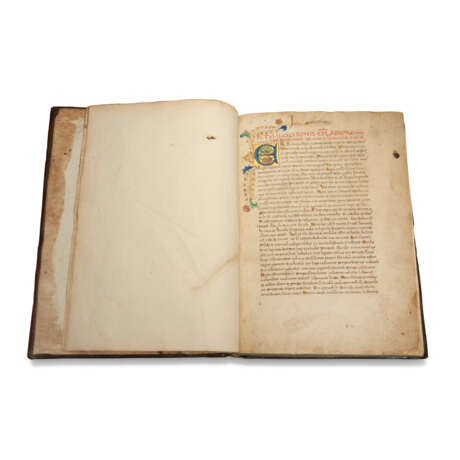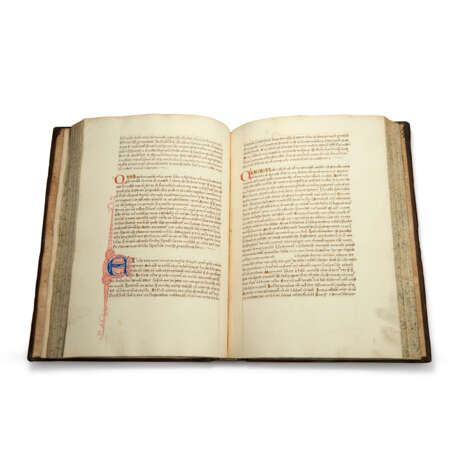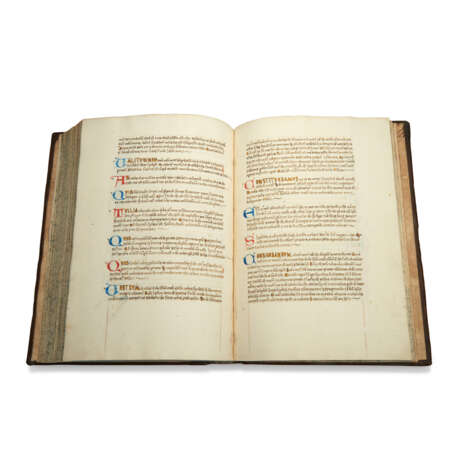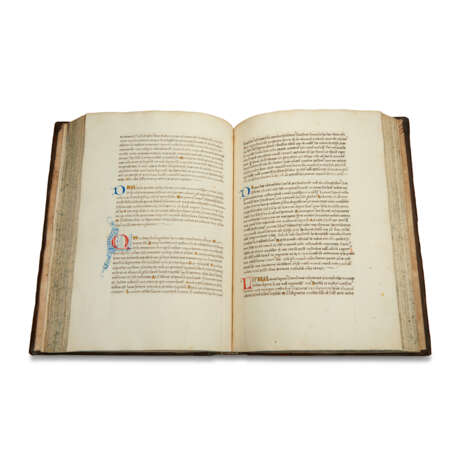ID 1105723
Лот 25 | Marcus Tullius Cicero (106-43 BCE)
Оценочная стоимость
£ 30 000 – 50 000
Cicero, Epistolae ad Familiares, in Latin, illuminated manuscript on vellum [Italy, probably Genoa, mid-15th century]
A handsome Italian Renaissance copy, likely owned by an itinerant French merchant, of one of the most important of Ciceronian texts: his correspondence with friends and acquaintances, complete and with wide, clean margins.
286 x 200mm. iii + 120 leaves + iii leaves, complete, collation: 1-1210, 35 lines in a semi-humanist hand, written space: 195 x 128mm, catchwords survive, capitals touched in yellow, rubrics in red, each letter beginning with a red or blue initial followed by first word in capitals touched in yellow, major sections separated by blue or red initials with ornate penwork flourishing of contrasting colour, one large illuminated initial with foliate extensions, spaces left for Greek text, 'Jesus Marie filius' at head of frontispiece (gold of initial a little rubbed, a few wormholes and stains, a few leaves discoloured and a little dampstained, else with wide clean margins and in excellent condition). 18th-century mottled calf over pasteboards (rebacked, a little scuffed).
Provenance:
(1) The watermarks fit into a tight-knit group of Briquet nos. 3694-3700, most closely resembling nos. 3695 (Genoa, 1449 and 1451-56) and 3697 (Genoa, 1458⁄60). The illumination of the initial appears northern, and finds close parallels in a contemporary Milanese copy of Aristotle, Nicomachean Ethics (Alexander and De la Mare, The Italian Manuscripts in the Library of Major J.R. Abbey, 1969, no 53, pl. LXVIIa). Although likely written in Genoa, the manuscript soon left Italy and made its way north, to France, which leads us to suggest that it was perhaps made for an itinerant merchant.
(2) Annotated on ff.61 (in French), 87 and on the recto and verso of the final leaf in a 16th-century French hand (f.120 carries the date 'a[nno] d[omi]ni 1517').
(3) 19th-century ownership inscription: 'Herries Dec 12th 1867 / a kind present from my friend William Bethell Esquire'. The latter is likely one of the Bethells of Rise Park, Yorkshire: either William Bethell (1847-1926), who in 1871-2 travelled to Victoria, New South Wales, Tasmania, New Zealand and Hawaii or, more likely, his father, William Froggatt Bethell (1810-1879), Justice of the Peace and High Sheriff of Yorkshire. 'Herries' may be William Constable Maxwell, Lord Herries (1819-1875), of Everingham Park, Yorkshire. A 19th-century dealer’s price code 'L/x˩/∆' is on the last pastedown.
Content: Cicero, Epistolae ad Familiares ff.1-120v.
Cicero's correspondence with friends and intimates, written between 62 and 43 BCE, is the most vivid and accessible of his writings to survive. It is an extremely important witness to the turbulent days of the failing Republic, with the self-conscious central Ciceronian narrative enhanced by other non-Ciceronian correspondents, making this corpus the richest ancient source for the letters of Republican writers other than Cicero. The text survived the collapse of the Roman Empire, with the earliest extant witness a leaf from a 5th- or 6th-century uncial codex with an abridgement of the text (Turin, D.IV.22: Codices Latini Antiquiores IV: 443), which was at Bobbio in the 7th century and reused to produce a copy of the works of Augustine. In the 9th century there were copies in various states of completeness in the library of the Imperial Abbey of Lorsch (see their library catalogue in Becker, Catalogi bibliothecarum antiqui, 1885, p.122, nos. 49-52). The complete text was rediscovered by Pasquino de’ Capelli, chancellor of Milan, at the instigation of the Florentine humanist scholar and scribe, Coluccio Salutati (1331-1406: see A.C. De la Mare, The Handwriting of the Italian Humanists, 1973, pp.30-43) in a 9th-century manuscript from Lorsch, now in Florence, Laurenziana MS. 49.9; he had it copied at Milan (that copy now Laurenziana MS. 49.7), and it is from that copy that almost all Italian Renaissance manuscripts of this text, including the present copy, descend.
| Адрес торгов |
CHRISTIE'S 8 King Street, St. James's SW1Y 6QT London Великобритания | ||||
|---|---|---|---|---|---|
| Предосмотр |
| ||||
| Телефон | +44 (0)20 7839 9060 | ||||
| Комиссия | see on Website | ||||
| Условия использования | Условия использования |






